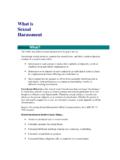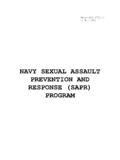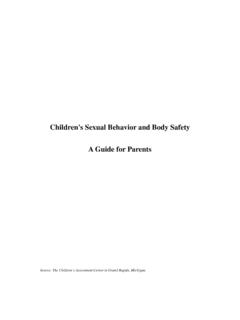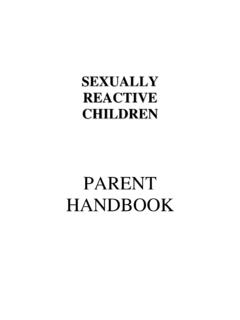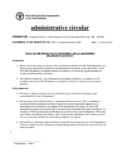Transcription of Sexual Harassment in Healthcare - - RN.org®
1 Sexual Harassment in Healthcare . Reviewed September 2017, Expires September 2019. Provider Information and Specifics available on our Website Unauthorized Distribution Prohibited 2017 , , , LLC. By Wanda Lockwood, RN, BA, MA. Purpose The purpose of this course is to define Sexual Harassment , describe court cases, describe prohibited behavior and types of Harassment , and steps required to file a complaint. Goals Upon completion of this course, the Healthcare provider should be able to: Discuss Title VII of the Civil Rights Act. Explain the role of the US Equal Employment Opportunity Commission (EEOC). Differentiate between quid pro quo and a hostile work environment. Describe at least 3 Sexual Harassment cases. Describe at least 4 prohibited behavior according to the EEOC.
2 List and describe 5 types of Sexual Harassment . Discuss those at risk for Sexual Harassment . Describe 5 elements of the complaint process. Introduction The Healthcare industry is not exempt from Sexual Harassment ; in fact, over 50% of female nurses, physicians, and students report experiencing Sexual Harassment . Sexual Harassment is unwelcome conduct, on the basis of gender, that affects a person's ability to do his or her job (or complete studies), including unwelcome Sexual advances, verbal or physical conduct of a Sexual nature, and requests for Sexual favors. Although most claims of Sexual Harassment are made by females, there have been increasing charges of Sexual Harassment of males. The original Civil Rights Act of 1964 prohibited discrimination based on race, sex color, national origin, or religion and protected females against Sexual Harassment .
3 Through revision (1991) and court decisions, the law has expanded to cover gender bias and Harassment against both males and females, including same-sex Harassment . Individual states have laws regarding Sexual Harassment , sometimes with broader application than Federal laws. The US Equal Employment Opportunity Commission (EEOC) is responsible for implementation of the laws. The Age Discrimination in Employment Act (ADEA) of 1967 prevents discrimination based on age and protects those 40 years and is often a co-factor in Sexual Harassment issues. Preventing Sexual Harassment and taking proactive steps to deal with Harassment that does occur is especially important, as the Supreme Court has ruled that employers are responsible for eliminating Sexual Harassment from the workplace.
4 In a 2004 decision, the Supreme Court ruled that an employer is strictly liable for Harassment that results from a supervisor's official act, but is subject to liability for other types of supervisor Harassment only if employer negligence is established, such as may occur if the employer fails to take appropriate action resulting from the claim. How is Sexual Harassment defined? The Supreme Court has outlined two different types of Sexual Harassment covered by Title VII of the Civil Rights Act: Quid pro quo: Job security, advancement, or benefits are tied to Sexual favors. This type includes unwelcome Sexual advances, requests for Sexual favors, or physical or verbal conduct of a Sexual nature that are tied directly or implicitly to employment.
5 Hostile work environment: Inappropriate behavior is so pervasive and severe that it permeates the workplace and interferes with the individual's ability to carry out the duties of the job. Quid pro quo is somewhat easier to understand because it's more straight-forward: Sleep with me if you want to keep your job doesn't leave a lot of room for interpretation; but, in fact, the pressure to provide Sexual favors may be more subtle and may be implied rather than directly stated. Let's go out for a drink and talk about that promotion may be a quid pro quo violation. Or not. Additionally, if the work environment becomes so intolerable due to Sexual Harassment that the person being harassed feels compelled to resign, this person can bring a charge of constructive discharge, which establishes a claim of quid pro quo because the employee was forced to lose employment because of Sexual Harassment .
6 If a person is fired, demoted, or refused promotion, receives a poor evaluation, or is reassigned to a lesser position because of rejecting a Sexual advance, this constitutes Sexual Harassment . If the same thing happens simply because the person is a female or a male, this also constitutes Sexual Harassment because the action was based on the person's gender. Hostile work environment violation is more subjective and covers a far wider range of behaviors, including unwelcome verbal, non-verbal, visual, psychological, and physical Harassment of a Sexual nature. More importantly, the Harassment does not have to be directed at the individual making the complaint. If an individual observes Sexual material or behavior or hears statements of a Sexual nature that offends him or her and interferes with the ability of that person to do his or her job, then that person is the victim of Sexual Harassment .
7 Most quid pro quo cases also include a hostile work environment. Court cases Female v Verizon A female employee charged she was constantly Communications, called a bitch and stupid and was denied Inc equipment, access to public restrooms, denied overtime, subjected to discipline for acts common to men, and forced to use bathrooms without locks. The court agreed this constituted a hostile work environment. Female v City of Female police officer charged she was denied Beaumont advancement because of gender despite being better qualified. Court agreed this was sex-based discrimination, quid pro quo. Female v Forklift A female worked as a manager and was Systems repeatedly insulted by the company president, who disparaged her gender and made Sexual innuendos and offensive statements about her to other employees.
8 The woman complained to the president about his behavior and he promised to stop but resumed Harassment again. She resigned and filed suit. The trial court ruled against her because she had not suffered injury (such as a nervous breakdown). However, the Supreme Court overturned this ruling, stating that a hostile environment need not be so severe as to cause severe psychological injury. This is an example of quid pro quo constructive discharge and a hostile work environment. Male v A male oilrig worker was harassed by male co- Sundowner workers, and was subjected to humiliating Offshore actions, including being held down and sodomized Services with a bar of soap. When he reported the (1998) Harassment to the supervisor, he was called an insulting name and no action was taken.
9 He resigned and filed suit. The lower court dismissed the suit because he was a male, but the Supreme Court overturned this ruling, stating that the Sexual Harassment laws apply to males and same-sex Harassment . This is an example of quid pro quo constructive discharge and a hostile work environment. Female v A female employee was subjected to continual Burlington Harassment by a supervisor, who threatened her Industries job if she didn't provide Sexual favors. She refused all advancements, and did receive a promotion, so he did not carry out his threats, and she did not report the Harassment . She resigned after 15 months and filed suit stating that the supervisor's treatment had essentially forced her to leave her job. The lower court found for her, a higher court ruled against her, but the Supreme Court overturned this ruling stating that employers are liable for the unwelcome and threatening Sexual advances of a supervisor, even if the threats are not carried out and the harassed employee suffers no adverse, tangible effects.
10 This is an example of quid pro quo constructive discharge and a hostile work environment. 15 Females v Del Fifteen female employees filed suit against Del Laboratories. Laboratories because the CEO sought Sexual favors in return for job benefits by making promises to women he harassed or threatening them with unfavorable working conditions if they refused his advancements. The court ruled this was both quid pro quo and a hostile work environment and awarded $1, 850,000. The Equal Employment Opportunity Commission (EEOC), responsible for enforcing workplace laws, outlines prohibited behavior: It is unlawful to harass a person (an applicant, employee, or student) because of that person's sex. Harassment can include Sexual Harassment or unwelcome Sexual advances, requests for Sexual favors, and other verbal or physical Harassment of a Sexual nature.











